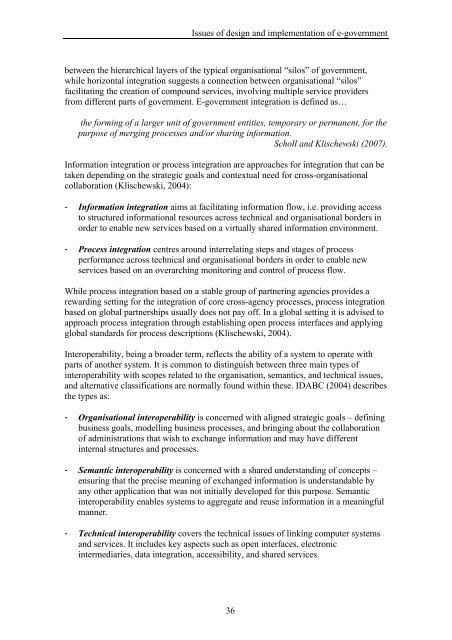Multi-channel provisioning of public services - Department of ...
Multi-channel provisioning of public services - Department of ...
Multi-channel provisioning of public services - Department of ...
You also want an ePaper? Increase the reach of your titles
YUMPU automatically turns print PDFs into web optimized ePapers that Google loves.
Issues <strong>of</strong> design and implementation <strong>of</strong> e-government<br />
between the hierarchical layers <strong>of</strong> the typical organisational “silos” <strong>of</strong> government,<br />
while horizontal integration suggests a connection between organisational “silos”<br />
facilitating the creation <strong>of</strong> compound <strong>services</strong>, involving multiple service providers<br />
from different parts <strong>of</strong> government. E-government integration is defined as…<br />
the forming <strong>of</strong> a larger unit <strong>of</strong> government entities, temporary or permanent, for the<br />
purpose <strong>of</strong> merging processes and/or sharing information.<br />
Scholl and Klischewski (2007).<br />
Information integration or process integration are approaches for integration that can be<br />
taken depending on the strategic goals and contextual need for cross-organisational<br />
collaboration (Klischewski, 2004):<br />
- Information integration aims at facilitating information flow, i.e. providing access<br />
to structured informational resources across technical and organisational borders in<br />
order to enable new <strong>services</strong> based on a virtually shared information environment.<br />
- Process integration centres around interrelating steps and stages <strong>of</strong> process<br />
performance across technical and organisational borders in order to enable new<br />
<strong>services</strong> based on an overarching monitoring and control <strong>of</strong> process flow.<br />
While process integration based on a stable group <strong>of</strong> partnering agencies provides a<br />
rewarding setting for the integration <strong>of</strong> core cross-agency processes, process integration<br />
based on global partnerships usually does not pay <strong>of</strong>f. In a global setting it is advised to<br />
approach process integration through establishing open process interfaces and applying<br />
global standards for process descriptions (Klischewski, 2004).<br />
Interoperability, being a broader term, reflects the ability <strong>of</strong> a system to operate with<br />
parts <strong>of</strong> another system. It is common to distinguish between three main types <strong>of</strong><br />
interoperability with scopes related to the organisation, semantics, and technical issues,<br />
and alternative classifications are normally found within these. IDABC (2004) describes<br />
the types as:<br />
- Organisational interoperability is concerned with aligned strategic goals – defining<br />
business goals, modelling business processes, and bringing about the collaboration<br />
<strong>of</strong> administrations that wish to exchange information and may have different<br />
internal structures and processes.<br />
- Semantic interoperability is concerned with a shared understanding <strong>of</strong> concepts –<br />
ensuring that the precise meaning <strong>of</strong> exchanged information is understandable by<br />
any other application that was not initially developed for this purpose. Semantic<br />
interoperability enables systems to aggregate and reuse information in a meaningful<br />
manner.<br />
- Technical interoperability covers the technical issues <strong>of</strong> linking computer systems<br />
and <strong>services</strong>. It includes key aspects such as open interfaces, electronic<br />
intermediaries, data integration, accessibility, and shared <strong>services</strong>.<br />
36
















